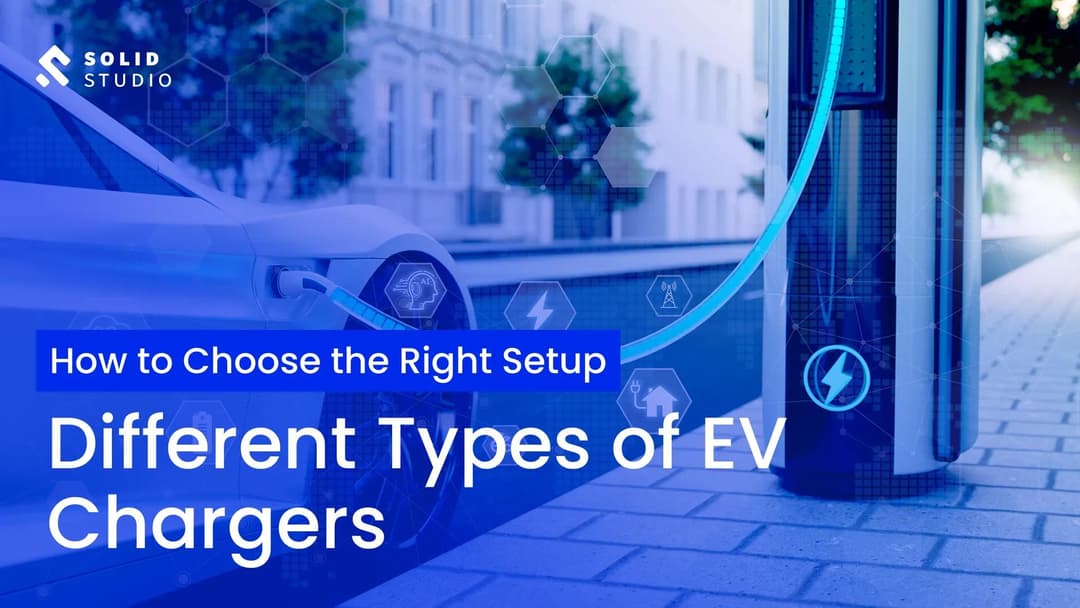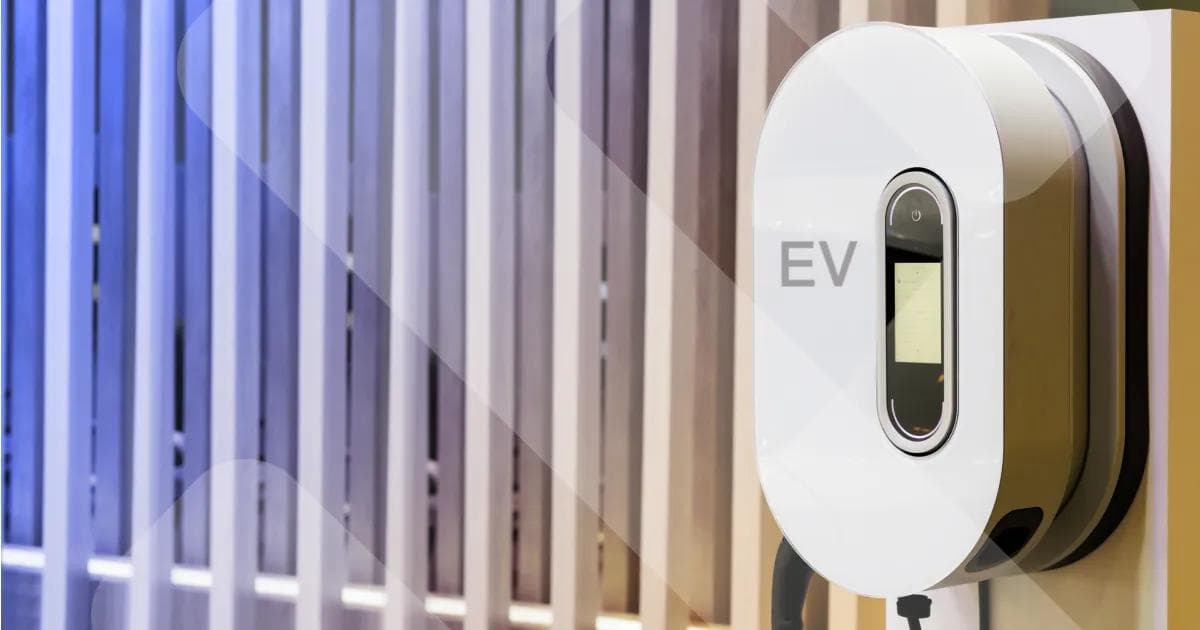Tl; dr;
The three types of EV chargers are Level 1 AC, Level 2 AC, and DC fast charging.
- Level 1 uses a standard 120V outlet and delivers 1.4–2.3 kW, adding ~6–12 km of range per hour: ideal for overnight home charging.
- Level 2 operates at 208–240V and delivers 3.7–22 kW, adding ~15–120 km/hour: suitable for homes, workplaces, and public spots.
- DC fast charging provides 50–400 kW and adds 120–800 km/hour, typically charging from 10% to 80% in 15–45 minutes: best for highways and fleets.
Not all charging units are created equal, and if you plan to develop infrastructure, the types of EV chargers you choose will define the user experience.
Between power levels, plug types, regional standards, and charging speeds, the differences will influence your operations. This guide categorizes EV chargers by level and connector type, enabling you to make informed decisions for home, public, or fleet deployments.
Charging levels explained
Level 1 EV charging: Low-speed, low-cost, and sometimes enough
Level 1 charging utilizes a standard 120V household outlet to deliver 1.4 to 2.3 kW, adding approximately 6–12 km of range per hour. While slow, it requires no installation and can be useful in settings where dwell times are long and grid upgrades aren’t practical.
For light EV use or plug-in hybrids, Level 1 may be enough. It also provides a universal fallback for emergencies or locations where Level 2 just isn’t viable, such as legacy apartment buildings or remote depots.
- Good for: Electric vehicle overnight charging, low-mileage users, PHEVs, long-dwell parking
- Avoid if: EV owners need >50 km/day or expect convenience
- Setup cost: None beyond the included electric vehicle supply equipment (EVSE) cable
🟩 Wrap up: Level 1 AC slow charger
- Power output: 1.4–2.3 kW
- Source: Standard 120V household outlet
- Speed: Adds ~6–12 km (2–5 miles) of range per hour of charging
- Use Case: Overnight charging at homes or small offices
- Cost: Minimal: standard cable, no extra hardware
- Limitations: Very slow; not suitable for daily long-distance driving
Level 2 EV charging: The daily driver of EV infrastructure
Level 2 is where real-world electric vehicle charging begins. Running on 208–240V, it delivers between 3.7 and 22 kW (7–11 kW is most common). That translates to ~15–120 km of range per hour, enough to fully charge most electric vehicles overnight or during a work shift.
It’s the go-to option for homes, commercial properties, office parks, hotels, and destinations. Level 2 chargers support AC power and a wide range of plug types (Type 1/J1772, Type 2/IEC), making them compatible with virtually all EV models.
- Good for: Homes, workplaces, commercial parking, depots
- Avoid if: You need turnaround times under 1 hour
- Setup cost: ~$500–$2,000 per unit, plus installation
🟩 Wrap up: Level 2 AC charging stations
- Power output: 3.7–22 kW (typically 7–11 kW for residential)
- Source: 208V or 240V dedicated circuit
- Speed: Adds ~15–120 km (10–75 miles) per hour of charging
- Use case: Homes, workplaces, public parking, commercial sites
- Cost: $500–$2,000+ for hardware + install
- Notes: Most EV drivers rely on Level 2 for daily use
DC fast charging: High-speed, high-cost, high-impact
Rapid DC chargers deliver power directly to the battery, bypassing the vehicle’s onboard charger. With power outputs from 50 to 400 kW, they can bring an EV from 10% to 80% in 15–45 minutes. That makes them essential for highway corridors, logistics fleets, and high-traffic locations.
But speed comes at a price. DC chargers require high-voltage infrastructure, advanced cooling, and grid coordination. They're also connector-specific, CCS, NACS, or CHAdeMO, so compatibility matters.
- Good for: Highways, fleet yards, fast-turnover locations
- Avoid if: You have limited grid capacity or low utilization
- Setup cost: $10,000–$100,000+ with grid upgrades
🟩 Wrap up: DC fast charging (Level 3 / HPC)
- Power output: 50–400 kW (High Power Charging or HPC >150 kW)
- Source: Direct current, high-voltage installation
- Speed: Charges 10–80% in 15–45 minutes
- Use case: Highways, fleet depots, transit hubs
- Cost: $10,000+ per charging unit plus major electrical upgrades
- Limitations: Not all electric vehicles support high-speed DC charging; tapering applies
Home vs. Public vs. Fleet charging: One size doesn’t fit all
Where a charger is installed matters just as much as what type it is. Home, public, and fleet charging all come with different constraints and different expectations.
Home charging
It's the most straightforward way of electric vehicle charging. It’s usually a Level 2 wallbox installed in a garage or driveway, used overnight when energy is cheapest and demand is low. For most EV owners, this covers 80–90% of their needs. It’s simple, convenient, and relatively low-cost to install, if the property allows it.
Level 2 wallbox EV charger
- Mostly level 2 EV chargers, sometimes level 1
- Installed in garages or driveways
- Controlled by the EV owner; peak usage is overnight
- Minimal installation cost for single-family homes
- Increasingly supported by smart charging apps and utility incentives
Public charging
Public charging is more complex. Here, you’re dealing with unpredictable users, short dwell times, and the need for reliability. Some locations, like hotels or retail lots, work well with Level 2 unit speed. Others, such as highway corridors or high-traffic areas, require ultra-rapid chargers to make sense. Visibility, access, uptime, and payment handling all matter.
- Often a combined charging system: Level 2 and DC chargers
- Found at malls, city centers, hotels, or rest stops
- Compared to private charging stations, usage is less predictable; high turnover matters
- Requires payment systems, signage, and regular maintenance
- Usually tied into larger charging networks for visibility and access
Fleet charging
Fleet and depot charging is its own category. These sites need a balance between overnight slow charging and rapid turnaround during the day. Charging schedules, energy loads, downtime risk—it all needs to be managed. That’s where things like load balancing, power management, and software integration come in.
Different users. Different needs. Different infrastructure. Planning around those differences is what makes an EV charging strategy scalable.
- Combined charging system depending on duty cycle: overnight Level 2, daytime fast charging stations
- Installed in controlled environments (logistics yards, bus depots, company HQs)
- Requires load balancing, scheduling, and often energy management systems (EMS)
- Costs are higher, but so is ROI through operational uptime
How to design an EV charging station
The way you design a charging station depends heavily on which EV chargers you decide to install. A residential garage with a wallbox looks nothing like a highway rest stop with 350 kW rapid units, and neither should the planning.
Level 1 sites are the simplest. Think apartment blocks, workplaces, or long-stay parking where cars sit all day. Here, design is about convenience and cost: making sure outlets are available, safe, and paired with spaces where drivers don’t mind leaving their car overnight.
Level 2 stations are where most of the real planning happens. These fit best in offices, hotels, shopping centers, and fleet depots. Layout matters: enough bays to serve demand, tethered cable reach for different vehicle sizes, and the right balance between the number of chargers and available grid capacity.
💡 Tip: Software for load management is no longer a “nice-to-have.”
DC fast charging hubs need space for larger vehicles, heavy cables, and cooling systems. Grid capacity often requires coordination with utilities or even on-site energy storage. Drivers expect a quick in-and-out experience, so design has to allow easy access, drive-through bays for trucks, and clear payment systems that work.
In short, Level 1 is about keeping costs low, Level 2 is about serving the daily majority, and rapid DC chargers are about speed and scale. The most successful sites don’t pick one; they combine them, so every driver finds what they need.
How fast is “rapid charging”?
When customers or drivers ask how long charging takes, the answer isn’t always simple. Speed depends on more than just the charger’s headline number.
kW vs. kWh
Kilowatts (kW) describe charging power, while kilowatt-hours (kWh) measure the energy stored in the battery. A 7 kW charger adds 7 kWh every hour. How far that gets you depends on the vehicle’s efficiency.
State of charge (SoC)
Electric vehicles charge fastest between about 10% and 60–70%. As the battery fills, charging slows down, a process called tapering.
Temperature
Batteries charge more slowly when it is too cold or too hot. That’s why thermal management and preconditioning matter.
Vehicle battery capacity
Some cars can only accept 7 kW AC, others 11 or 22 kW. The same applies to DC: if a car maxes out at 150 kW, plugging into a 350 kW charger won’t make it faster.
In practice:
- Level 1 → Full charge in 20–40 hours (mostly impractical).
- Level 2 → 4–10 hours for a full battery, overnight or during a shift.
- DC fast chargers → 10–80% in 15–45 minutes, depending on charger power and battery capacity.
The bottom line: “fast” is always relative to the vehicle, the charger, and the use case.
Costs and when each type makes sense
The price of an EV charger goes beyond the hardware. Installation, grid upgrades, and software integration all drive the total cost of ownership. Choosing the right level is about matching cost to expected usage.
Level 1 slow charger (1.4–2.3 kW)
- Cost: $0–$200 (cable included with most vehicles)
- When it makes sense: Private garages, light PHEV use, or as a fallback option.
- Limitations: Too slow for daily all-EV reliance, not scalable commercially.
Level 2 (3.7–22 kW)
- Cost: $500–$2,000+ per charging unit, plus installation (wiring, permits, load checks).
- When it makes sense: Homes, workplaces, hotels, destinations. The sweet spot for daily EV charging.
- Limitations: Requires electrical capacity; not fast enough for highway or fleet turnaround.
DC fast chargers (50–400 kW)
- Cost: $10,000–$100,000+ per unit, often with major grid upgrades.
- When it makes sense: Highways, logistics depots, transit hubs, everywhere where fast turnaround is critical.
- Limitations: Expensive to deploy and maintain, utilization must justify the investment.
The takeaway: Level 2 covers most EV charging needs. DC charging is about throughput, not convenience. And Level 1 remains the cheapest, but only for edge cases.
How to choose the right charger
With so many charger types, it’s easy to overcomplicate the decision. But most choices come down to a few practical questions:
How far do your drivers travel each day?
If it’s under 50 km, Level 1 might be enough. Over 100 km? You’ll need Level 2 or faster.
Do you control the parking space?
Homes with garages can handle Level 2 wallboxes. Public sites and depots will likely need a mix of Level 2 and DC fast chargers.
What can your electric vehicles actually accept?
Some EVs cap AC charging at 7 kW, others at 11 or 22 kW. On the DC side, a car limited to 150 kW won’t benefit from a 350 kW charger.
What is the maximum power the grid allows?
Local electrical service may cap your options. In some cases, installing multiple Level 2 units is more practical than one DC fast charger.
What’s the budget?
Level 2 offers the best cost-to-coverage ratio. DC fast delivers speed, but only makes financial sense where utilization is high.
Is there a public network nearby?
If drivers already have access to reliable DC fast charging on highways, your role might be to provide affordable Level 2 at destinations.
The smartest deployments don’t think in terms of “which charger is best.” They think in terms of mix and context: matching charging levels to actual driver behavior and infrastructure limits.
Connector types: Regional differences
EV charging might feel universal at first glance, but once you look across borders, it’s a patchwork of standards. For anyone planning infrastructure or managing a fleet, these differences will shape your business strategy.
EVSE charging connector types
In Europe, things are relatively straightforward. Type 2 is the standard AC plug, and CCS2 is the standard connector for DC fast charging. The EU has mandated CCS2 for all new public chargers, which makes deployment much easier.
North America is in transition. For years, the mix was SAE J1772 for AC and CCS1 for DC. Now, the Tesla-developed NACS (recently standardized as SAE J3400) is gaining broad support. Vehicle manufacturers from Ford to GM are adopting it, and networks are racing to add NACS cables alongside CCS1.
In Japan, the story is different. CHAdeMO still serves as the fast-charging standard, but its global relevance is fading. For operators, it often means maintaining older equipment for a shrinking share of vehicles.
And then there’s China, which follows its own GB/T standards for both AC and DC. These plugs aren’t compatible with Western vehicles, making cross-border travel challenging and limiting charger interoperability.
Ready to plan your charging stations strategy?
If you want to pick the right types of EV chargers, you have to align infrastructure with real-world use. The right mix depends on your drivers, your sites, and your business model.
Start small if you need to, but plan for growth. Whether it’s Level 2 for everyday use or DC fast for high-throughput sites, a clear strategy makes the difference between chargers that sit idle and chargers that generate value.
At Solidstudio, we help companies entering the EV world with electric vehicle charging software built for scale. From tariffs and roaming to session control and reporting, our platforms keep your network efficient, compliant, and user-friendly.
Talk to us about your EV charging strategy →
FAQ: Types of EV chargers
What are the three types of EV chargers?
Level 1 AC, Level 2 AC, and DC fast charging. Level 1 delivers 1.4–2.3 kW, Level 2 delivers 3.7–22 kW, and DC fast chargers range from 50–400 kW.
What’s the difference between Level 2 and DC fast charging?
Level 2 uses AC power and takes 2–8 hours for a full charge. DC fast charging uses direct current, charging 10–80% in 15–45 minutes.
Which plug do I need in Europe vs. the US?
Europe: Type 2 for AC, CCS2 for DC. US: SAE J1772 for AC, CCS1 or NACS/SAE J3400 for DC.
What connector do Tesla vehicles use?
Tesla uses the North American Charging Standard (NACS), recently approved as SAE J3400. It supports both AC and DC charging through the same compact plug. Many non-Tesla vehicle manufacturers will adopt it in North America from 2025 onward.
How long does it take to charge from 10% to 80%?
With DC fast, 15–45 minutes depending on power and vehicle. With Level 2, 2–8 hours. Level 1 is impractical for this range.
Does more kW always mean faster charging?
Not always. Speed is limited by the vehicle’s maximum charge rate, state of charge, and battery state and temperature.
Can I use an adapter safely?
Yes, but only certified adapters rated for your vehicle and charger. Improper adapters can cause overheating or fail to deliver full power.
What is an AC charger?
An AC charger supplies alternating current to the vehicle. The car’s onboard charger converts it to DC to store in the battery. Level 1 and Level 2 chargers are AC.
What is a DC charger?
A DC charger supplies direct current directly to the battery, bypassing the onboard charger. This allows much faster charging, commonly called DC fast charging.



